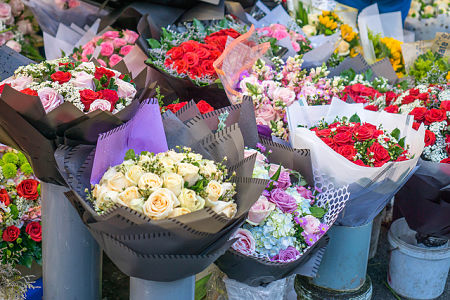Say it with flowers
/Red tulips are “an open declaration of passion.”
Flowers are the gift of choice today on Valentine's Day but they're a welcome way to celebrate any special occasion. We use them to say “I love you,” “Happy birthday” or “Congratulations!”
In earlier eras, the language of flowers was infinitely more complex and floral messages were spoken in many tongues. Chrysanthemums, for instance, were the exclusive emblem of Japanese emperors. The handsome (but vain) Greek youth known as Narcissus gave his name not only to a daffodil but to the syndrome of egotism.
Page up a few centuries and you come to the age of “floriography” when perfectly proper Victorians used floral arrangements to convey coded messages, often about feelings that couldn’t be spoken aloud. This popular practice had roots in a number of books published in Europe between 1700 and 1800 that described the flower codes of Turkish harems, another setting in which emotions were closely guarded. Flower talk really took off under the influence of Queen Victoria who embraced the whole idea with enthusiasm and spread it around the entire British Empire.
Tussie-mussies or “talking bouquets” were sent by family, friends and especially by suitors to their prospective lady-loves. These small, compact nosegays could convey a medley of sentiment. Combine peonies (bashfulness) with forget-me-nots (true love), and you might capture the attention of a girl you were reluctant to approach face-to-face. Red tulips were an open declaration of passion and yellow ones marked the sender as hopelessly in love. This had to be a lot more fun than e-mail or text messages.
If you think the language of flowers is strictly passé, a quaint artifact of the past, think again. The royal florist – of course there is one – carefully designed Kate Middleton’s bridal bouquet for the Wedding of Weddings with an eye to what the flowers meant. All in traditional white, the bouquet included Sweet William (for gallantry), hyacinth (constancy), lily-of-the-valley (return of happiness), ivy (fidelity) and myrtle (a symbol of marriage).
In the United States of the 1800s, the language of flowers was at first spoken among novelists and poets, especially female ones. Frances Sargent Osgood, a friend of Edgar Allen Poe, published “The Poetry of Flowers and the Flowers of Poetry,” which remained in print for more than 20 years after its publication in 1841. It was, in short, a full-blown fad.
So many choices, all steeped in secret messages. — Marco Verch/Flickr
Today this charming and romantic custom is ripe for revival. Not all of the lists of floral symbolism agree, naturally, since they originated in different times and places. The Society of American Florists has published its own “official” list at aboutflowers.com as a handy guide for modern bouquet buyers.
Some occasions are too important to leave to ambiguity. There are birthday flowers to complement gemstones associated with each month: Carnations for January, roses for June, and asters for September. Wedding anniversaries also have assigned flowers with red and white roses for the first, signifying unity; bird of paradise for the third, conveying magnificence, and red carnations for the 17th, speaking of deep love and passion.
Since you can’t count on everyone to understand the lingo, a little card explaining the sentiments behind the flowers in your bouquet might add an extra dimension to your gift. On the other hand, the more subversive among us could compose their own mixed messages and remain completely mum. Not every flower communicates a warm and sympathetic greeting, after all.
How about a bunch of pink zinnias and blue lobelia: “I’m thinking of absent friends…with dislike.” Or a spray of begonias surrounding a single white rosebud: “Warning -- too young for love.” It could be dangerous if someone’s on to you, but red roses and yellow foxgloves offer this unwelcome head’s up: “I love you…insincerely.”
In an era of Twitter feeds, instant messaging and virtual communication, there’s something wonderfully appealing about a return to communication steeped in tradition, intrigue and arcane code. At the very least, you could be speaking knowledgeably from the heart when you say it with flowers.
More good reading
“The Secret Language of Flowers: Rediscovering Traditional Meanings” by Shane Connolly (Rizzoli International Publications)
“A Victorian Flower Dictionary: The Language of Flower Companion” by Mandy Kirkby ( Ballantine Books)
“The Language of Flowers: A Novel” by Vanessa Diffenbaugh ( Ballantine Books)


